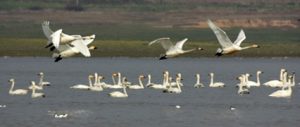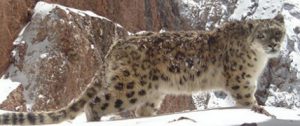The largest rodent eradication campaign in history is set to poison millions of rats on the sub-Antarctic island of South Georgia. Scientists say the mammalian massacre – planned for 2013 and 2014 – will restore starkly beautiful South Georgia to the position it once held as the world’s most important nesting site for seabirds.
Although South Georgia’s birds are still spectacular in the breeding season, they are a shadow of the avian extravaganza that was there before seafarers in the late 18th century inadvertently introduced rats to what had been a pristine environment. The island’s ground-nesting birds have not evolved to cope with the voracious appetite of alien rodents for their eggs and chicks.
“If we can eradicate the rats, the consensus among people who know about seabirds is that at least 100 million of them will reclaim their ancestral home on South Georgia,” says Tony Martin, a biology professor at the University of Dundee who is on secondment to lead the project. “Then it will again have the greatest concentration of birds on the planet.”
South Georgia is the latest – and by far the largest – island to be tackled by a growing ecological movement to get rid of animals that play havoc with native wildlife after being introduced deliberately or accidentally by people. An estimated two-thirds of all birds and reptiles that have gone extinct through human activity lived on islands (which account for 5% of earth’s landmass). Though rats and mice have done the most damage, cats, foxes, ferrets, weasels, pigs, goats, deer, rabbits and other alien species have been targeted in eradication campaigns around the world.
At 800 square miles, South Georgia is seven times the size of New Zealand’s Campbell Island, currently the largest area ever cleared of rodents. The successful blitz on Campbell Island rats in 2001, carried out with 132 tonnes of poison dropped from five helicopters, has led to a renaissance of native species. Seabirds are returning, and duck and snipe have been rescued from the brink of extinction.
“New Zealand pioneered the techniques for ridding islands of rats – and in essence our operation on South Georgia is New Zealand technology writ large,” says Martin. “Some New Zealanders will be helping our campaign, including our chief pilot, Peter Garden, who was also chief pilot for the eradication projects at Campbell Island and Rat Island, in the Aleutian chain of the north Pacific. Peter was set to retire but could not resist tackling South Georgia.”
In fact the South Georgia project has already had a successful trial run. In March 2011, helicopters dropped 55 tonnes of the rat poison brodifacoum over an area of 132 square kilometres that is isolated from the rest of the island by glaciers.
A year later, intense monitoring shows no signs of rats or their droppings in the treated area, though the team cannot be sure yet that none have survived the mass poisoning. “It is very hard to prove a negative but we are pretty confident that there are no rats left,” says Martin. “Just as important, we are already seeing signs of recovery among the birds.” The threatened South Georgia pintail, a duck found nowhere else on earth, has produced more ducklings in the area than at any time in living memory.
Phases two and three in 2013 and 2014 respectively will involve dropping as much as 300 tonnes of brodifacoum from the air onto every part of the island where rats might conceivably live. It is a heroic operation, carried out during the stormy southern autumn when the rats are hungry and the risks of inadvertently poisoning native wildlife are less than in the more clement spring and summer months. “Ideally we’d do it in winter but the weather makes that too risky,” Martin says.
Collateral damage to other species is a big issue in rat-eradication campaigns. Although most ecologists regard the removal of introduced rodents from the eponymous Rat Island in the Aleutians in 2008 as a huge long-term gain for the native birds, the unexpected poisoning of 43 bald eagles was a short-term public relations setback.
Brodifacoum is wrapped in bait pellets so attractive to rodents that rats will eat them in preference to their natural food. The poison is an anticoagulant that kills rodents through internal bleeding and organ failure.
As the rats succumb to the chemical, they become photophobic (scared of light) and retreat to die in their burrows. This makes them less likely to harm any other creatures that eat the dead or dying rats. Most carnivorous birds on South Georgia eat only marine prey – the island has no raptors such as eagles or hawks and no native land mammals, reptiles or amphibians – and experts believe the native birds are unlikely to be tempted to eat the bait directly.
However, the team recognised that there might be some casualties among avian scavengers such as skuas, gulls and giant petrels. Some brown skuas did indeed die in the weeks following the first phase of rat poisoning last year but the species recovered completely when more birds returned to breed six months later.
A complication of the South Georgia campaign is that the resident reindeer – introduced early in the 20th century to provide food for Norwegian whalers – must be removed before rat eradication moves into its main phases. Otherwise the deer will eat the bait. Botanists are also keen to see the 3,000 reindeer gone because they are severely overgrazing the native plants.
The government of South Georgia – a British overseas territory administered from the Falkland (Malvinas) Islands – has undertaken to remove the deer in time for the 2013 blitz on the rats, though it has not finally decided whether to do so by shooting them from the air or ground or by corralling and herding them.
After the cull, the only reindeer left in South Georgia will be on the crest of the island’s official coat of arms. “When we realised, it raised a chuckle,” says Martin. “But it was pointed out that there are no lions roaming around Britain, though there is a lion on the UK coat of arms.”
The rat eradication itself, however, is funded mainly by the South Georgia Heritage Trust, a conservation charity, though the UK government has contributed too through the Department for Environment, Food and Rural Affairs (DEFRA). The trust is still looking for donations to ensure that it can finish the job successfully, at a total cost estimated the equivalent of US$11 million.
The ecological payback will be priceless. “This isn’t a job; it’s a vocation, a crusade,” Martin says. “The full benefits will take decades to arrive, because some of these birds are very slow breeders but others [such as the pintail duck and South Georgia pipit, the island’s native songbird] respond almost immediately.
“The buzz you feel when the first green shoots of recovery appear is hard to put into words.”
https://www.ft.com/home/uk
© Copyright The Financial Times Limited 2012
Image of black-browed albatrosses, which breed in South Georgia, by man_with_noname


